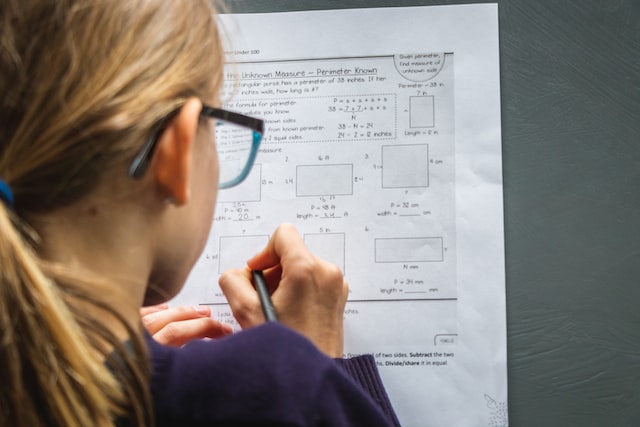When it comes to problem solving in math, there are many different strategies to choose from. It’s important to select the right strategy for the problem at hand.
Strategies For Problem Solving in Math
For example, if you’re facing a difficult math word problem, try brainstorming ideas to solve it. This is a great way to think of solutions and avoid tunnel vision.
Visualization
Visualization is an important strategy to consider when problem solving in math. Using visualization to solve problems can help students understand the problem, determine the best way to approach the task, and make better decisions.
Several studies have shown that visual thinking is an important aspect of learning mathematics. In particular, diagrams and graphical representations are known to foster the retention of facts. These representations can also help learners in problem-solving tasks by facilitating specific inferential processes (e.g., Larkin & Simon, 1987).
However, the research on the use of visualization in math teaching has been relatively new. Many of the studies were conducted with children with learning disabilities, and many have focused on helping students improve their external visual representation strategies such as using diagrams and graphs to represent information.
In addition, researchers have explored how internal visual representation strategies are important in math education. They have found that students often use images in their head to represent the information they are trying to learn. This can be useful for students who have learning disabilities because it allows them to process the information in their own minds without having to rely on an outside visual stimulus.
One study examined the relationship between visualization and problem-solving among primary school students. The researchers asked participants to solve six common problems in an interview setting. The students were then asked to report on their problem-solving processes and roles of visualization during the process.
The researchers discovered that students used visualization more when they were faced with novel problem situations and their teacher had a preference for visual methods. They also tended to use visualization when they were not sure what method to use for the problem.
Direct Reasoning
Deductive reasoning is a key pillar in the teaching of mathematics. It involves the use of logical arguments to answer questions and determine whether or not certain statements are true.
In the context of problem solving, deductive reasoning is important because it allows students to reach a decision without needing to use trial and error. It also provides a more efficient way of determining the validity of mathematically accepted statements.
However, the ability to apply logical-deductive reasoning can be difficult for students to develop. This is especially true for young students who are still learning how to reason effectively.
This problem-solving skill requires a clear understanding of the properties of numbers, patterns inside and throughout sets of numbers and how operations affect these numbers. Developing this understanding is called number sense.
Research has shown that students who do not have a strong understanding of numbers do not perform as well on math tests, even after they have completed school. For this reason, teachers should focus on teaching students how to make the most of their number sense so that they can apply it in the classroom and beyond.
Another important aspect of number sense is understanding the underlying structure of word problems. For example, many word-problems involve a formula or graphic organizer that can be used to solve the problem.
For this reason, it is crucial for teachers to teach students how to understand and apply the schemas in math word problems. This can be done through several strategies, including using diagrams and visualizing the structure of a problem.
Alternatively, students can be taught to solve math problems by using their knowledge of math vocabulary and concepts. This strategy can be effective for some students, but it may not be as useful for others, who require more complex constructions to solve word problems.
Logical-deductive reasoning is an essential part of mathematics, but it is often difficult for students to use. This problem-solving skill can be improved through the use of a variety of strategies, including rote practice, visualization, and trial and error.
Making Up Numbers
Students can use a variety of strategies when solving math problems. One of the most important strategies is making up numbers. This strategy is particularly effective when students are struggling with difficult questions. In addition to being an excellent way to test each answer choice, it also helps students to think about the question and problem without numbers at first.
When kids are learning how to make up numbers, they’re also building their understanding of the concepts behind adding and subtracting. The idea is to create a number that makes sense in relation to the separate amounts. This is a skill that can be developed in different ways for all children, but it’s important to develop it as early as possible.
A good example of using this strategy is to make up a number that’s equal to the difference between two sets of numbers, such as 27 and 15. It’s easy to do this for simple numbers, but it can be more difficult for larger ones, or for a long series of problems.
Another approach is to take a series of smaller problems, and then work up to the big one. This can be an effective strategy for students who are afraid of larger numbers or who find them too confusing to handle.
During a number talk, teachers can pose a problem on the board and allow all students to think of a solution. Some teachers even hold hands to show they’re thinking about a solution, which can help other students focus on the thinking.
Once they’ve come up with a solution, the teacher can write it on the board and ask for feedback from students. Often, this helps students understand the problem better and can lead to new strategies.
When a student is making up numbers, it’s important to note whether they’re working with single digit or multiple digit numbers. If they’re working with a single digit, they’re likely to get stuck when it comes to finding the right solution.
In a multidigit problem, students may need to start by drawing a diagram or list of possible number pairs that have the ratio 5:3. This is a great strategy for teaching how to visualise abstract problems.

Trial and Error
Problem solving is a critical aspect of learning mathematics. It teaches students to approach problems from various angles and use their knowledge to find solutions. It is also a way to build confidence and persevere through adversity.
When you are facing a challenge, it is important to take breaks and give yourself time to think. You should also allow yourself enough time to sleep if you need to. This will help you come up with a solution that works best for you.
One of the most popular and effective problem-solving strategies is trial and error. This strategy is used by many people to solve problems in different fields, including physics. It can also be useful when trying to discover new drugs and other solutions.
In a trial and error approach, you try out different things until you get a solution that works. However, this method can be time-consuming and can be difficult to master.
Another effective strategy is to work backwards. This approach is often taught to help students solve math problems, but it can also be useful in real-world situations. For example, if you’re designing a product and need to figure out how much money you’ll need, you can work backwards to see what steps are required to create the end result.
This method is particularly useful for solving process-related problems, as it allows you to visualize the different processes and how they interact with each other. You can draw diagrams of each step, and you can even jot down notes or write down what’s going on in your head as you think of solutions.
Sometimes, the solution to a problem will come to you in a flash of inspiration or suddenly make sense when you’re stuck. This is called insight-based problem solving. Insight-based problem solving relies on the unconscious process of recognizing patterns and coming up with solutions that you would never have thought of on your own.
This strategy is an excellent way to come up with creative solutions to problems, and it can be helpful for solving word problems. It can also be a useful tool when you’re working through a puzzle or challenging problem.
